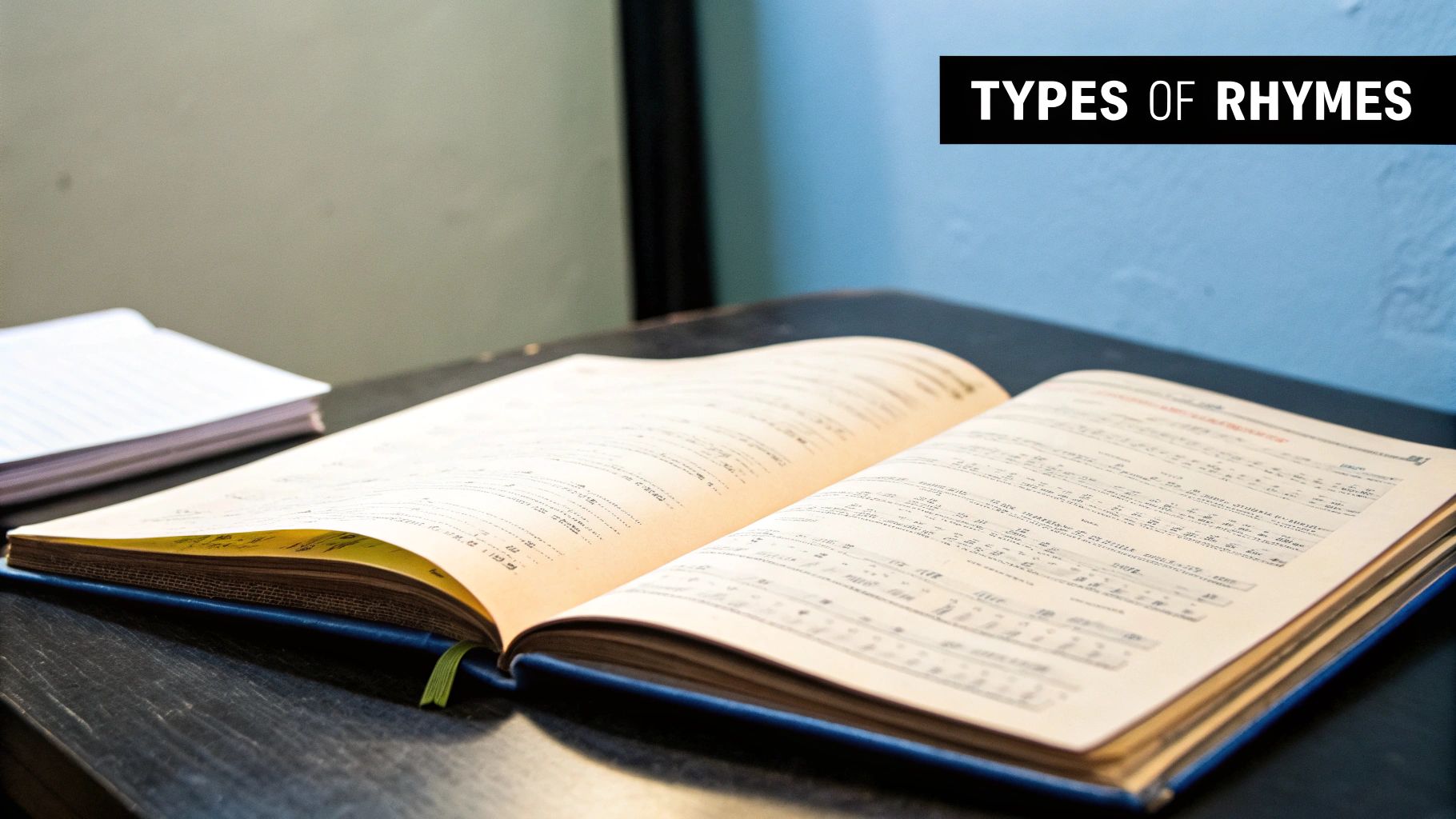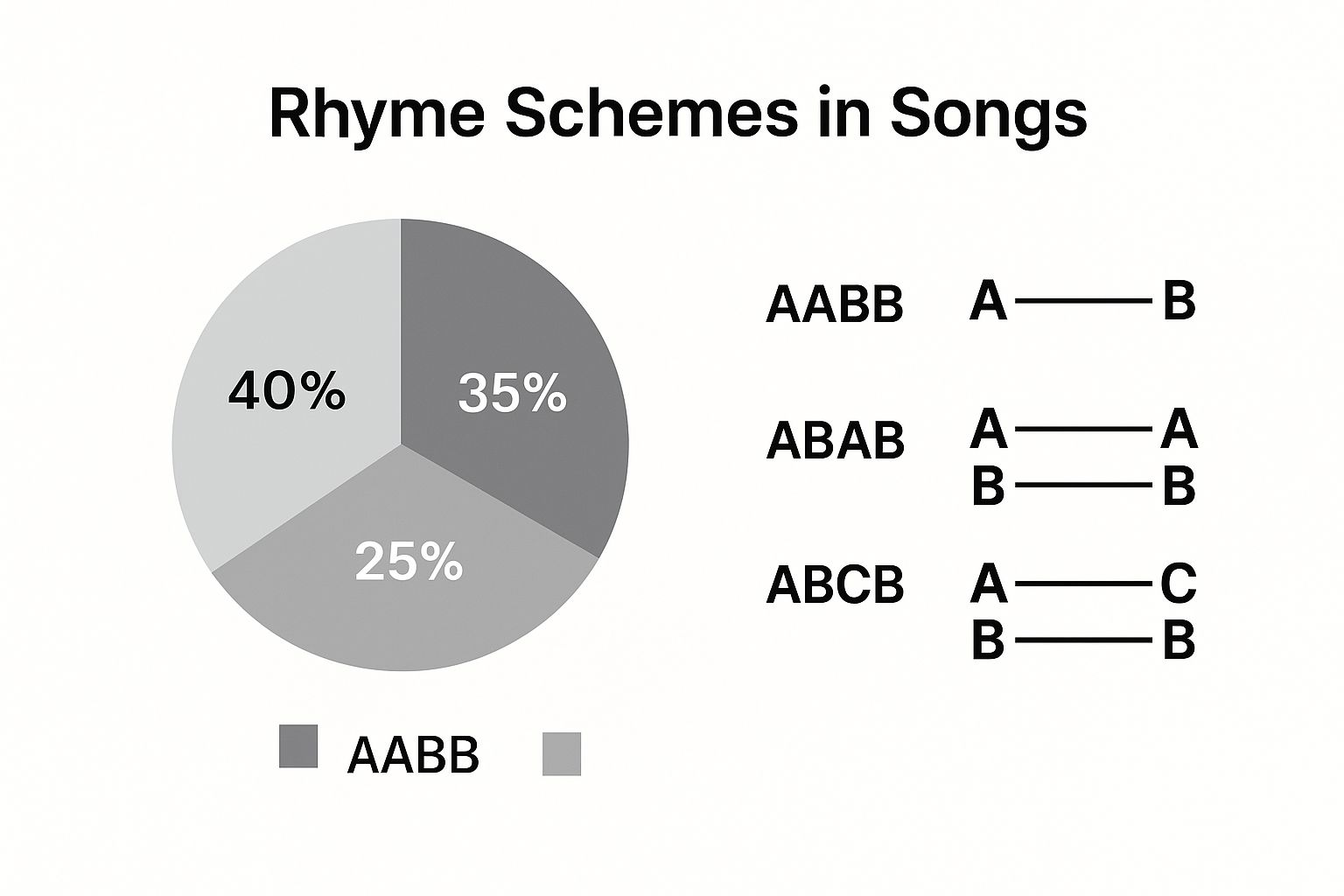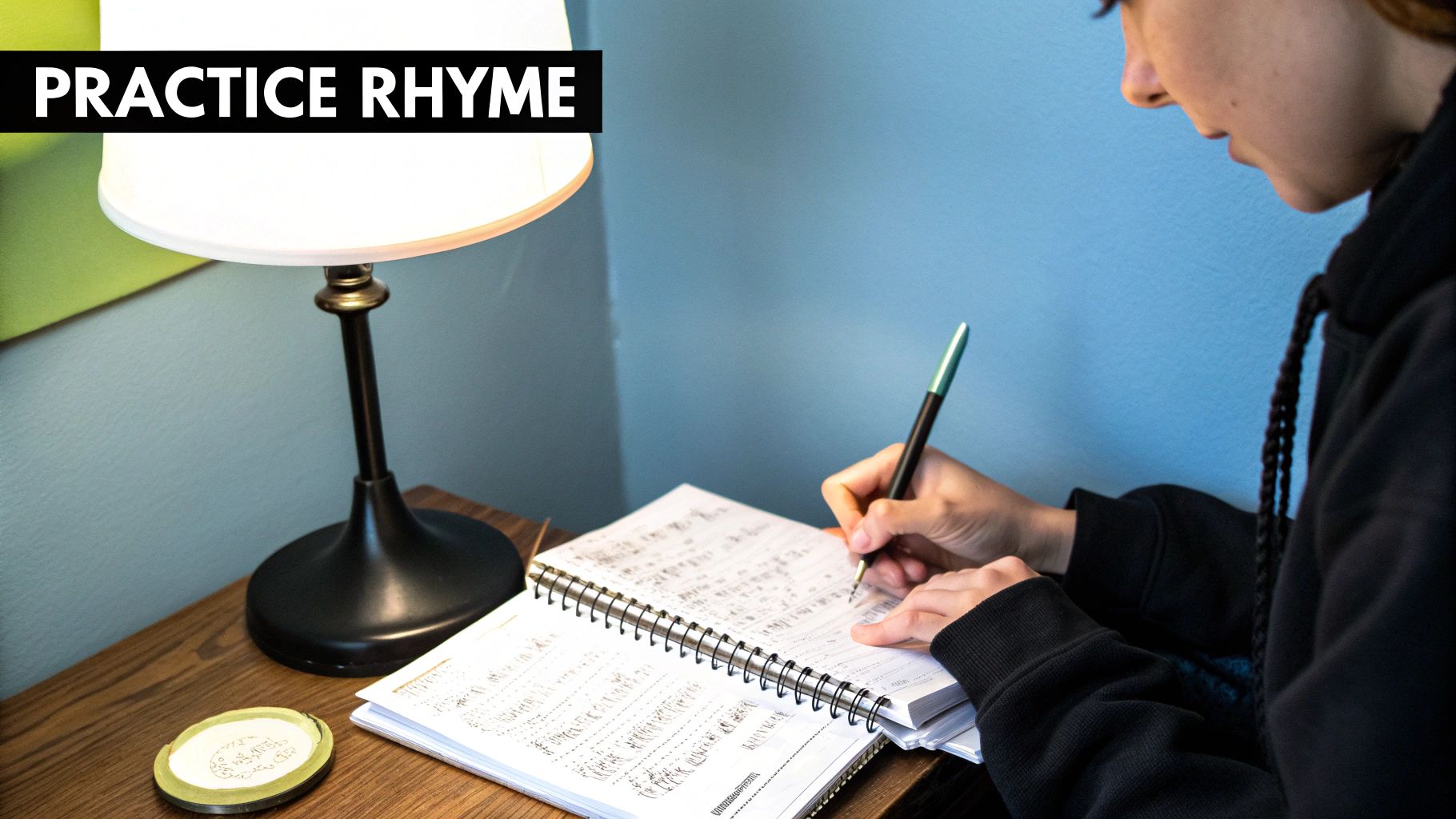Understanding Musical Blueprints: What Makes Songs Stick
Have you ever had a song stuck in your head, even one you haven't heard in years? That's the power of a strong rhyme scheme. Think of it as the architecture of your lyrics. Just as a building needs solid foundations, a memorable song needs a well-defined rhyme structure. This structure makes lyrics easier to recall and strengthens their emotional impact. Let's explore how these patterns work and why some combinations resonate more than others.
This "stickiness" comes down to our brain's love for patterns. When we hear a rhyme scheme, our brain recognizes a familiar structure, creating a sense of satisfaction and anticipation. Common patterns like AABB, where the first and second lines rhyme and the third and fourth lines rhyme, offer comfort and predictability. This predictability makes the song easy to follow and internalize.
But there's more to it than just simple rhyming. The true skill lies in using rhyme schemes to amplify the meaning and emotional depth of your lyrics.
For instance, a song about heartbreak might use an ABAB scheme, where the first and third lines rhyme, and the second and fourth lines rhyme. This back-and-forth pattern can evoke a sense of longing and unresolved tension, mirroring the song's emotional core. On the other hand, a joyful, upbeat song might use an AAAA scheme, where all lines rhyme, to emphasize feelings of exuberance and unity. The choice of rhyme scheme directly shapes the overall mood and message.
It's fascinating how the number of possible rhyme schemes grows exponentially with the number of lines. A four-line verse has 15 mathematically possible rhyme schemes, from the straightforward AABB to more intricate arrangements. However, only a handful are commonly used in songwriting. The Bell numbers illustrate this explosion of possibilities: one for a single line, two for two lines, five for three lines, and 15 for four.
To better understand this, let's look at a table summarizing the relationship between the number of lines in a verse and the rhyme scheme possibilities.
Common Rhyme Schemes by Number of Lines
Mathematical breakdown of possible vs. practical rhyme schemes in songwriting
| Lines | Total Possible Schemes | Commonly Used | Examples |
|---|---|---|---|
| 2 | 2 | AA, AB | "Twinkle, twinkle, little star" (AA), "Baa, baa, black sheep" (AA), "Mary had a little lamb" (AABCBC – but in pairs of 2 lines, AB) |
| 3 | 5 | AAA, AAB, ABA | "The Itsy Bitsy Spider" (AABB – but in groups of 3 lines at a time as AAB) |
| 4 | 15 | AABB, ABAB, AAAA | "Amazing Grace" (ABAB), "House of the Rising Sun" (AABB) |
As you can see, while the theoretical possibilities are numerous, songwriters tend to gravitate towards familiar and accessible structures like AABB, ABAB, and AAAA. This reflects a balance between creative expression and audience comprehension. You can learn more about the intricacies of rhyme schemes on Wikipedia. The next section will explore these commonly used patterns in more detail and discuss their influence on popular music.
Chart-Topping Patterns: The Rhyme Schemes That Rule Music

Ever notice how some songs just click? How they possess a natural, almost ingrained sense of flow? That's often due to the rhyme scheme. These patterns form the backbone of many hit songs, creating a satisfying sense of anticipation and release. Think of it like a well-paced conversation, where each line responds to the previous one in a pleasing rhythmic exchange. This section explores those patterns, explaining why they work and showcasing some of the songs that made them famous. You might also find our guide on how to write song lyrics helpful as we delve in.
The ABAB Blueprint: A Conversational Flow
One of the most common rhyme schemes you'll encounter is the ABAB pattern. Picture a musical dialogue: the first and third lines rhyme (A), answering each other across the second and fourth lines, which also rhyme (B). This back-and-forth creates a sense of give-and-take that feels comfortable and familiar to the listener. The ABAB scheme provides a sweet spot between predictability and surprise, giving songwriters room to be creative within a solid structure. This versatility allows it to work beautifully in both quiet ballads and powerful anthems.
Consider the timeless hymn "Amazing Grace." Its ABAB structure is part of what makes it so enduring. The rhyme scheme allows the spiritual message to unfold with a gentle, conversational rhythm. This pattern's effectiveness has been proven across genres and centuries. Even in modern genres like rap, the ABAB scheme shines. Rae Sremmurd uses it to great effect in their hit "Black Beatles." Discover more insights on rhyme schemes in rap.
The AABB Powerhouse: Concise and Catchy
Next up is the AABB pattern, where the first two lines rhyme (A), followed by another rhyming pair (B). This structure delivers ideas in concise, satisfying packages, offering a strong sense of closure. This makes it perfect for short, punchy lines, making it a staple in pop and rock music. Think of the chorus of your favorite catchy pop song—chances are, the AABB pattern is there, working hard to make that hook stick in your head.
The AABB pattern can also amplify a song's emotional impact. By pairing rhyming lines, songwriters can create a sense of unity and intensity, ensuring their message hits home. This structure offers a strong foundation for memorable melodies and lyrics that resonate. It’s a classic for a reason – it simply works.
Beyond the Basics: Exploring Other Patterns
While ABAB and AABB are the most common, other patterns like ABCB and AAAA also play a role in songwriting. The ABCB scheme introduces an element of unpredictability. It breaks the expected flow of ABAB while still offering a satisfying rhyme. The AAAA scheme, with all four lines rhyming, can create a powerful sense of unity and emphasis, especially effective in choruses or emotionally charged verses. The key is to choose the rhyme scheme that best serves the song's message and the feeling you’re aiming for. It’s about finding the perfect match between form and emotion.
The Psychology Behind Earworms: Why Some Songs Never Leave
Ever had a song stuck in your head, playing on repeat like a broken record? We call these catchy tunes "earworms," and they're a fascinating example of how rhyme schemes affect our brains. Our minds love patterns, and a good rhyme scheme delivers a satisfying sense of order and predictability.
This predictability isn't just pleasing to the ear; it's fundamental to how we process and remember information. Think about it – you might recall lyrics from a childhood song easier than what you had for lunch yesterday. Rhyme schemes create a mental loop, making words easier to store and retrieve from memory.
That's the same reason jingles in commercials are so effective. Their repetitive nature, often built on simple rhyme schemes, is designed to burrow into your brain. It's the same principle at play in many of your favorite songs.
Rhyme Schemes and Emotion
Rhyme schemes also tap into our emotions. A particular pattern can amplify the feeling behind the lyrics, making a song more memorable and moving. A melancholic ballad might use an ABAB rhyme scheme, creating a sense of longing and reflection. The alternating rhymes mirror the ebb and flow of unresolved feelings.
Conversely, a celebratory anthem might use an AAAA rhyme scheme to boost feelings of unity and joy. The repeated rhyme emphasizes shared experience, making the emotion more potent. In popular music, rhyme schemes are key to creating songs that resonate and stick with listeners.
The Power of Familiarity
Historically, the most common rhyme scheme in four-line verses is rhyming the second and fourth lines. This pattern appears in countless hits across genres. It creates a satisfying sense of anticipation and resolution, something listeners have come to expect.
Songwriters can use this familiarity as a foundation for creativity. By working within this established structure, they can introduce fresh ideas without alienating listeners. This balance of comfort and surprise is the secret sauce for crafting lyrics that resonate and endure.
This explains why traditional rhyme schemes remain effective even with so many creative options available. Master songwriters understand how to use familiar patterns as a launchpad for something new. They strike a balance between the familiar and the unexpected, crafting lyrics that connect with audiences and linger long after the song ends. And this isn’t just theory; it’s practical advice you can use to write more memorable lyrics yourself. For more tips on avoiding common rhyming mistakes, check out this helpful article: 5 Song Rhyming Pitfalls and How to Avoid Them.
Genre DNA: How Different Styles Shape Their Rhyme Schemes
Just like regional dialects add flavor to a language, different musical genres have their own unique "dialects" when it comes to rhyme. These aren't just random choices; they're deeply tied to the heart and soul of each genre, reflecting its purpose and what listeners expect. Think of country music, with its emphasis on storytelling. The rhyme schemes often feel like a natural conversation, letting the story unfold easily, like a friend sharing a memory. Hip-hop, on the other hand, thrives on rhythmic complexity and lyrical acrobatics. Here, intricate rhyme schemes showcase skill and push the beat forward. Pop music walks a fine line, balancing catchy simplicity with just enough complexity to keep things interesting.

This infographic gives us a visual snapshot of how often three common rhyme schemes (AABB, ABAB, and ABCB) appear in popular music. It also shows a line diagram of each pattern. As you can see, AABB and ABAB are the most popular, but ABCB adds a nice touch of variety, offering a pleasant surprise while still providing a satisfying rhyme structure. This variety underscores how different patterns create distinct rhythmic feels. Each scheme provides a unique framework for writing memorable lyrics.
To better illustrate how genre influences rhyme scheme preferences, let's look at the following table:
Rhyme Scheme Preferences by Musical Genre
Comparison of how different genres utilize rhyme schemes for their unique storytelling needs
| Genre | Preferred Schemes | Purpose | Notable Examples |
|---|---|---|---|
| Country | AABB, ABAB | Reinforces narrative, creates familiarity | Classic country ballads, storytelling songs |
| Hip-Hop | Complex, internal, slant rhymes | Rhythmic drive, lyrical dexterity | Many rap songs emphasize intricate rhyme patterns |
| Pop | AABB, with variations | Balances accessibility and innovation | Pop songs often vary schemes for verse/chorus contrast |
This table provides a quick overview of how different genres utilize rhyme schemes for their unique storytelling needs. As we delve deeper into each genre, we'll see more clearly how these preferences play out in practice.
Country's Storytelling Heartbeat
Country music often uses straightforward, familiar rhyme schemes like AABB and ABAB. These patterns create a comfortable, relatable feel, reflecting the genre's focus on everyday stories and genuine emotion. Picture those classic country ballads – the rhyme scheme often reinforces the narrative, making it easy for the listener to follow along. This simple approach helps connect listeners with the heart of the song. It's like sitting around a campfire, listening to a friend share a personal story.
Hip-Hop's Rhythmic Gymnastics
Hip-hop, in contrast, thrives on complex rhyme schemes. This isn’t just about showing off lyrical skills; it's about propelling the rhythm and creating a captivating flow. Internal rhymes, slant rhymes, and intricate multi-syllabic rhymes are all key tools in the hip-hop arsenal. These complex structures add layers of texture and meaning, turning lyrics into rhythmic instruments. This density of rhyme makes hip-hop incredibly engaging and demonstrates a masterful command of language.
Pop's Balancing Act
Pop music walks a tightrope between being accessible and being innovative. While simple schemes like AABB are common, pop songwriters often mix things up to keep listeners hooked. They might use a more complex scheme in a verse to create contrast or build tension, then switch back to a simpler pattern for the chorus to make it extra catchy. It’s a delicate balance, ensuring the song is both instantly appealing and subtly surprising. This allows pop music to connect with a wide audience while still pushing creative boundaries.
Deconstructing Hit Songs: Rhyme Schemes in Their Natural Habitat
Ever wonder how some songs just stick with you, burrowing their way into your brain and refusing to leave? A big part of that magic comes down to rhyme schemes. Let's explore how these patterns work in the wild, dissecting hit songs to understand their power. We’ll look at everything from classic rock anthems to modern pop hits and intricate hip-hop tracks, uncovering the subtle variations that make familiar schemes feel fresh. This isn't just theory; it's a practical look at how the pros balance predictability and creative surprises.
This screenshot from Genius.com shows a popular song's lyrics annotated with the rhyme scheme and other lyrical devices. It's a visual reminder that rhyme schemes, while invisible when listening, provide the underlying architecture that supports a song's impact. Genius.com is a fantastic resource for songwriters looking to analyze their favorite tracks and see how the sausage is made, so to speak. These insights reveal how different genres have developed unique rhyme scheme preferences, reflecting their individual characteristics and history.
Classic Rock Anthems: Uniting Crowds Through Rhyme
Imagine a packed stadium roaring along to Queen's "We Are the Champions." Its simple but powerful AABB rhyme scheme in the chorus ("…world/ …heard/ …word/ …stirred") creates a sense of unity. This easily digestible pattern transforms individual experiences into a collective moment of shared emotion. It’s accessible and contributes to the song’s enduring appeal, demonstrating how a straightforward rhyme scheme can be incredibly effective in crafting an anthem.
Modern Pop Hits: Balancing Catchiness and Complexity
Modern pop often walks a tightrope between familiar and surprising rhyme schemes. A song might use a predictable AABB pattern in the chorus for that earworm effect, then shift to a more complex scheme in the verses to add depth and keep listeners engaged. This balance allows artists to create songs that are both catchy and intriguing, satisfying our need for familiarity while also piquing our interest.
Hip-Hop's Rhythmic Tapestry: Complex Schemes and Lyrical Prowess
Hip-hop often uses intricate rhyme schemes as a showcase for lyrical dexterity and complex rhythms. Think of Eminem's complex internal rhymes and multi-syllabic rhyming patterns, which add layers of texture and meaning to his music. This complexity becomes a defining characteristic of the genre, contributing to the unique rhythmic drive that makes hip-hop so distinctive.
Through this comparison, we see how the same basic building blocks of rhyme can be adapted to create wildly different emotional effects, from heartbreaking ballads to high-energy celebrations. By studying how established artists use rhyme schemes, you gain invaluable inspiration for your own writing. This practical knowledge bridges the gap between theory and practice, empowering you to craft lyrics that resonate with your audience. Understanding the rhyme scheme DNA of hit songs allows you to apply these principles to your own music, adding another tool to your songwriting arsenal.
From Theory to Practice: Your Rhyme Scheme Writing Toolkit

So, you’re ready to move beyond rhyme scheme theory and start crafting actual songs? Great! Think of this section as your songwriting toolkit, filled with practical techniques to help you build lyrical masterpieces. We’ll explore how to weave rhyme schemes into your songs to create compelling and memorable lyrics.
Choosing the Right Rhyme Scheme
First things first: choose a rhyme scheme that resonates with your song's message and mood. Imagine a tender heartbreak ballad. An ABAB pattern, with its gentle back-and-forth flow, might be the perfect fit. Now picture a high-energy, celebratory anthem. Here, the unifying power of an AAAA scheme could really drive the point home. The right rhyme scheme from the start can prevent awkward, forced rhymes later.
Let’s say you’re writing a song about overcoming adversity. An ABCB scheme, with its unexpected twist, could beautifully reflect life’s unpredictable turns. Suddenly, your rhyme scheme isn't just a structural element; it's part of the story itself.
Consider mapping out your chosen scheme before you even start writing lyrics. This blueprint will guide your word choices and ensure a smooth, natural flow to your song. Just like an architect uses blueprints to design a building, you can use a rhyme scheme as your blueprint for a cohesive and compelling song.
Finding Natural-Sounding Rhymes
The best rhymes feel effortless, like they were meant to be. Focus on rhymes that serve your lyrics, not the other way around. Don't contort your message to fit a rhyme. Let the meaning guide you.
Try brainstorming words related to your song's theme. Then, explore the potential rhyming connections between them. Think of it like connecting the dots. You're searching for the most natural and meaningful paths between your ideas. For more lyric-writing tips, check out our guide on tips for writing song lyrics.
Varying Your Patterns
While consistency is good, too much repetition can make a song feel stale. Varying your rhyme schemes can keep listeners engaged while still maintaining a cohesive structure. Think of it like adding spices to a dish. A little variety enhances the flavor without overpowering it.
You might use a simple AABB scheme in your verses, then switch to a more intricate ABAB pattern in the chorus to amplify the emotional impact. This contrast highlights key sections and keeps the listener on their toes. It’s a strategic way to emphasize the emotional highs and lows of your song.
Breaking the Rules (Strategically)
Sometimes, breaking your own rules can be a brilliant move. A strategically placed non-rhyming line can create emphasis or draw attention to a specific phrase. It's all about knowing when to stick to the structure and when to deviate for artistic effect.
But these deviations should be intentional, adding to the song’s overall impact, not detracting from it. Think of a jazz musician improvising over a melody. Those unexpected notes create moments of surprise and emotional depth. You can do the same with your rhyme scheme.
Rescuing a Troubled Rhyme Scheme
What if your rhyme scheme just isn’t working? Don't panic! There are ways to salvage it without starting over. Sometimes, rearranging lines or swapping a few words can make all the difference. Flexibility and a willingness to experiment are key.
This process of revision and refinement is essential to songwriting. It’s about continually evaluating and adjusting your work until you achieve the desired effect. Like a sculptor chiseling away at marble, you’re shaping and refining your lyrics until they perfectly capture your message. This toolkit gives you the essentials for crafting a rhyme scheme that amplifies your song's emotional core, creating a deeper connection with your listeners.
Avoiding the Pitfalls: Common Mistakes That Weaken Your Lyrics

Even when you understand how rhyme schemes work in songs, there are still traps to watch out for. Let's explore some common mistakes songwriters make. After all, recognizing these pitfalls is the first step towards avoiding them. This section will help you develop a feel for when your lyrics are shining and when they need a little polishing.
The Forced Rhyme: A Songwriter's Nemesis
One of the biggest offenders is the forced rhyme. This happens when a songwriter prioritizes rhyme over meaning, bending the lyrics into unnatural positions just to make the words match. Imagine trying to cram a suitcase full of clothes into a space half its size—it’ll zip, but the contents inside might get damaged. The result often feels awkward and clunky, interrupting the song's natural flow. For instance, shoehorning in a word that doesn't fit the context can jolt the listener and lessen the song's impact.
This is a common trap for beginners, but even seasoned songwriters can fall into it. The key is to focus on the clarity and emotional honesty of your lyrics. The rhyme scheme should enhance your message, not control it. If a rhyme feels like a struggle, it’s usually better to rewrite the line completely than to force a weak connection. Learn more in our article about songwriting tips for crafting memorable lyrics.
When the Rhyme Scheme Fights the Flow
Sometimes, a rhyme scheme can work against the song itself. A complex pattern might look great on paper but sound jarring and unnatural when sung. This can happen if the rhyme scheme disrupts the song’s phrasing or creates awkward pauses. It’s like trying to fit together puzzle pieces from different boxes—they simply won’t connect smoothly.
In these cases, it’s important to realize that the rhyme scheme is holding the song back, not helping it move forward. Simplifying the pattern or adjusting the phrasing can make a big difference. The goal is to ensure the rhyme scheme serves the song, not the other way around.
Mismatched Moods: Rhyme and Emotion
Another subtle but vital aspect is aligning your rhyme scheme with the song's emotional tone. A light, playful song might benefit from a simple, predictable rhyme scheme, while a more introspective or melancholic piece might do better with a more complex and subtle pattern.
Picture a sad ballad with a bouncy, sing-songy rhyme scheme. The contrast can diminish the song’s emotional impact. It’s important to consider how the rhyme scheme contributes to the overall mood and atmosphere you’re trying to create.
Cleverness Overload: Too Much of a Good Thing
Finally, be careful not to overdo it with clever rhymes. While intricate rhyme schemes can be impressive, they can also distract the listener. If your audience is more focused on deciphering your rhymes than connecting with your message, you’ve gone too far. Think of a meal with too many competing flavors—it overwhelms the palate.
The goal is to create a rhyme scheme that elevates the song, not steals the show. It’s a balancing act, and sometimes simplicity is key. The focus should always be on conveying your message clearly and effectively.
By understanding these common pitfalls, you can hone your songwriting and create lyrics that are both musically captivating and emotionally resonant. Check out ChordX for more helpful resources on music production and songwriting. Explore ChordX today!



